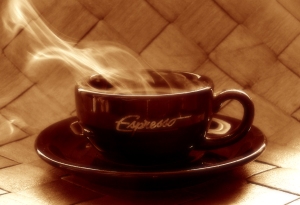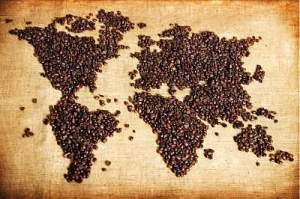Americano: A single shot of espresso with about 7 ounces of hot water added
Hammerhead (A Shot in the Dark): A shot of espresso served in a coffee cup and filled with drip coffee
Caffe Latte: Single shot of espresso with steamed milk at approximately a 3:1 ratio of milk to coffee
Cappuccino: Traditionally made with equal parts espresso, steamed milk and frothy milk.
Dry Cappuccino: An espresso drink made with a tiny bit of foam and no steamed milk.
Mocha: Most often a Cappuccino or a Caffe Latte with chocolate syrup added.
Espresso Con Panna: A shot espresso with whipped cream.
Double Shot: Two shots of espresso added to the other ingredients included in the drink of your choice
Cafe Macchiato: A shot of espresso or in a demitasse (small espresso cup) topped with steamed milk. Ratio of approximately 80/20 and often served with a teaspoon of sugar mixed in.
Cafe Breva: More or less like a cappuccino made with half and half rather than whole milk.
Frappe: Originally a cold espresso, it has more recently been prepared putting 1-2 teaspoons of instant coffee with sugar, water and ice. The brew is placed in a long glass with ice, and milk if you like, turning it into a big coffee milkshake.
Instant coffee (or soluble coffee): freeze-dried coffee turned into soluble powder or coffee granules.
Irish coffee: A coffee spiked with Irish whiskey, with cream on top.
Turkish Coffee (also known as Greek Coffee): Made by boiling finely ground coffee and water together to form a muddy, thick coffee mix. It’s often made in what’s known as an Ibrik, a long-handled, open, brass or copper pot. It is then poured, unfiltered, into tiny Demitasse cups, with the fine grounds included. It’s then left to settle for a while before serving, with sugar and spices often added to the cup.
Kopi Tubruk: An Indonesian-style coffee that is very similar to Turkish and Greek , it’s very thick, but the coarse coffee grounds are actually boiled together with a solid piece of sugar. The islands of Java and Bali tend to drink this brew.
Melya: A coffee mixed with 1 teaspoon of unsweetened powdered cocoa and drizzled honey. Sometimes served with cream.
Lungo: is an extra long pull that allows somewhere around twice as much water as normal to pass through the coffee grounds usually used for a single shot of espresso.
Ristretto: The opposite of a Lungo, the name of this variety of coffee means ‘restricted’, which means, less water is pushed through the coffee grounds than normal, even though the shot would take the same amount of time as normal for the coffee maker to pull.
Vietnamese style coffee: A drink made by dripping hot water though a metal mesh, with the intense brew then poured over ice and sweetened, condensed milk. This process uses a lot more coffee grounds and is thus a lot slower than most kinds of brewing.
White coffee: A black coffee with milk added.
http://www.talkaboutcoffee.com
Kopi Luwak the most expensive coffee in the world does exist, and those who drink the expensive coffee insist that it is made from coffee beans eaten, partly digested and then excreted by the Common palm civet, a weasel-like animal.
“Kopi” the Indonesian word for coffee along with “luwak” is local name of this animal which eats the raw red coffee beans. The civet digests the soft outer part of the coffee cherry, but does not digest the inner beans and excretes them.
Apparently the internal digestion ends up adds a unique flavor to the beans, removing the bitter flavor, and then beans are then picked up by locals and sold. The most expensive coffee beans can cost up to $600 a pound, and up to $50 per cup, if you can get over the fact that you are drinking such a strange brew.

